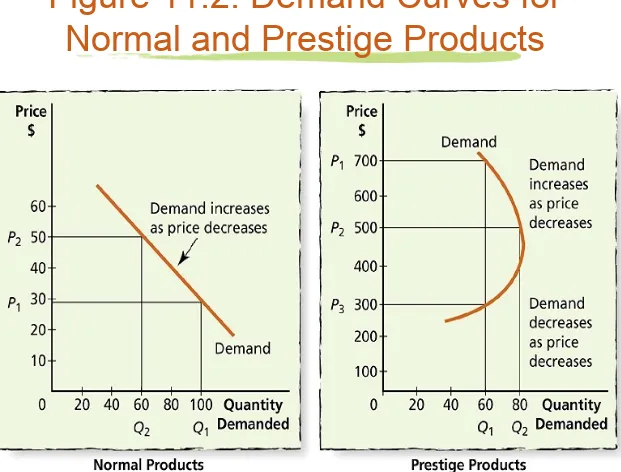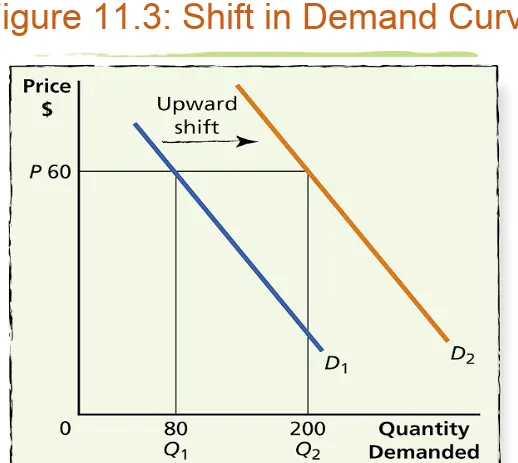2 Chapter Objectives
• importance of pricing
• monetary & non-monetary
forms of pricing
• pricing objectives
3 Chapter Objectives
• using costs, demands, and
revenue
to make pricing decisions
• environmental factors
4 Chapter Objectives
• key pricing strategies
• pricing tactics
for single products multiple products,
5 Chapter Objectives
• Internet pricing strategies
• Psychological aspects of pricing • Legal aspects of pricing
6 “Yes, but what does it cost?”
• Price:
the assignment of value,
or the amount the consumer must exchange • to receive the offering
• Offerings:
Money, goods, services, favors, votes,
7
Figure 11.1: Steps in
Kotler
9
Step 1: Develop Pricing Objectives
• Sales or market share objectives
• Profit objectives
• Competitive effect objectives
• Customer satisfaction objectives
• Image enhancement objectives
Step 2
12 Step 2: Estimate Demand
• Demand:
• customers’ desires for a product
13 Demand Curves
• Law of demand:
as price goes up,
quantity demanded goes down.
• For prestige products,
15 Figure 11.2: Demand Curves for
16
Shifts in Demand Curve
1. Changes in marketing strategy
(improved product, new advertising)
or
2. non-marketing activities
can cause upward or downward shifts in demand.
At a given price,
18 Estimating Demand
• Marketers predict total demand by estimating potential buyers for a product,
then multiplying number of buyers times • average amount of each buyer’s purchase.
• Then they predict what the company’s
19
Elastic Demand
• A change in price results
• in a substantial change in quantity demanded.
If price is increased, revenues decrease, and vice-versa.
Non-necessities (pizza)
generate elastic demand.
Availability of close substitute
20
Inelastic
Demand• A change in price
• has little or no effect on quantity demanded.
If price is increased, revenues increase.
The demand for necessities
21
Cross-elasticity of Demand
• Changes in prices of other products affect a product’s demand.
Products are substitutes:
• increase in price of one will increase demand for other (bananas vs. strawberries).
One product is essential for use of second: • increase in price of one decreases demand for
Step 3
23 Step 3: Determine Costs
• Variable costs:
• costs of production (raw, processed
material, parts, labor) that are tied to and vary depending on the number of units
produced.
Average variable costs may change
24 Step 3: Determine Costs
• Fixed costs:
• costs of production that don’t change with number of units produced
Rent,
cost of owning/maintaining factory, utilities,
equipment,
25 Step 3: Determine Costs
• Fixed costs:
Average fixed cost:
fixed cost per unit (total fixed costs divided by number of units produced)
26 Step 3: Determine Costs (cont’d)
• Total costs:
• total of fixed costs & • variable costs
27 Break-Even Analysis
• the number of units a firm must produce and sell
at a given price to cover all its costs.
• Break-even point:
point at which a firm doesn’t lose any money and doesn’t make any profit.
28 Break-Even Analysis (cont’d)
• Break-even point (in units) • = (total fixed costs)
• divided by (contribution per unit)
Contribution per unit:
29 Break-Even Analysis (cont’d)
• Break-even point (in dollars)
• = (total fixed costs)
30
Marginal Analysis
• A method that uses
• cost and demand
• to identify the price
31
Marginal Analysis
• Marginal cost:
increase in total costs from producing one additional unit of a product
• Marginal revenue:
increase in total income or revenue from selling one additional unit of a product (decreases with each
additional unit sold)
• Profit is maximized
Step 4:
33 Step 4: Evaluate the Pricing
Environment
• The economy
Broad economic trends
Recessions (Price sensitive
Consumers), Inflation
Step 5:
35 Step 5: Choose a Price Strategy
• Pricing strategies based on cost
Simple to calculate and relatively risk free
Cost-plus pricing:
36 Step 5: Choose a Price Strategy
(cont’d)
• Pricing strategies based on
demand
Based on estimate of quantity a firm can sell at different prices
37 Step 5: Choose a Price Strategy
(cont’d)
• Pricing strategies based on demand Target costing:
• identify quality and functionality
–customers need and
• price they’re willing to pay
–before designing product.
38 Step 5: Choose a Price Strategy
(cont’d)
• Pricing strategies based on demand Yield management pricing:
• charge different prices • to different customers • to manage capacity
39 Step 5: Choose a Price Strategy
(cont’d)
• Pricing strategies based on the competition
Pricing near, at, above, or below the competition
Price leadership strategy: • industry giant announces price, and • competitors get in line
• or drop out
40 Step 5: Choose a Price Strategy
(cont’d)
• Pricing strategies based on customers’
needs
Value pricing or
everyday low pricing (EDLP):
43 Step 5: Choose a Price Strategy
(cont’d)
• New-product pricing
Skimming price:
a very high premium price (TIVO, RIM, Mobile Phone,
Kindle)
45 Step 5: Choose a Price Strategy
(cont’d)
• New-product pricing
Penetration pricing: a very low price
to encourage more customers to purchase
46 Step 5: Choose a Price Strategy
(cont’d)
• New-product pricing
Trial pricing:
low price for a limited period of time
Step 6:
48 Step 6: Develop Pricing Tactics
• Pricing for individual products
Two-part pricing:
offering two separate
types
of payments to49 Step 6: Develop Pricing Tactics
• Pricing for individual products
Payment pricing:
50 Step 6: Develop Pricing Tactics (cont’d)
• Pricing for multiple products
Price bundling:
selling two or more goods or services as a single package
51 Step 6: Develop Pricing Tactics (cont’d)
• Pricing for multiple products
Captive pricing:
pricing two products
52 Step 6: Develop Pricing Tactics (cont’d)
• Distribution-based pricing
F.O.B. (free on board) origin pricing F.O.B delivered pricing
Basing-point pricing
53 Step 6: Develop Pricing Tactics (cont’d)
• Discounting for channel members
List price (suggested retail price):
• price that manufacturer sets • as appropriate
54 Step 6: Develop Pricing Tactics (cont’d)
• Discounting for channel members
Trade or functional discounts:
set percentage discounts
• off list price
55 Step 6: Develop Pricing Tactics (cont’d)
• Discounting for channel members
Quantity discounts:
reduced prices
56 Step 6: Develop Pricing Tactics (cont’d)
• Discounting for channel members
Cash discounts:
enticements to customers to pay bills quickly
(2% 10 days, net 30 days)
57 Step 6: Develop Pricing Tactics (cont’d)
• Discounting for channel members
Seasonal discounts:
price reductions
59 Pricing and Electronic Commerce
• Dynamic pricing strategies:
• seller easily adjusts price
• to meet changes in marketplace.
60 Pricing and Electronic Commerce
• Dynamic pricing strategies:.
Cost of changing prices on Internet is practically zero.
Firms can respond quickly and frequently
to changes in costs, supply, and/or demand.
61 Pricing and Electronic Commerce
• Online auctions (eBay.com)
E-commerce allows shoppers to purchase products
62 Pricing and Electronic Commerce
(cont’d)
• Pricing advantages for online shoppers
Consumers gain control.
Search engines and “shopbots”
• make customers more price-sensitive.
63 Psychological Issues in Pricing
• Buyer’s pricing expectation
Internal reference price:
consumers use a price/price range to evaluate product’s cost.
• Assimilation effect
64 Psychological Issues in Pricing
• Buyer’s pricing expectation
Price/quality inferences:
• consumers assume higher-priced product
65 Psychological Pricing Strategies
• Odd-even pricing:
prices ending in 99 rather than 00 lead to increased sales.
• Price lining:
67 Legal and Ethical Considerations
• Deceptive pricing practices
68 Legal and Ethical Considerations
• Unfair sales acts
Loss-leader pricing Unfair sales acts
69 Legal and Ethical Considerations in
Pricing (cont’d)
• Price fixing:
two or more companies conspire
to keep prices at a certain level
Horizontal price fixing
70 Legal and Ethical Considerations in
Pricing (cont’d)
• Predatory pricing:
• company sets a very low price
• for purpose of driving
72


